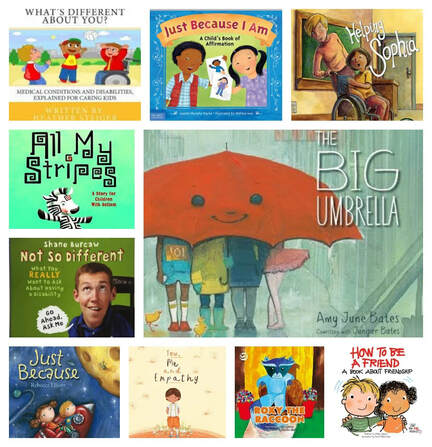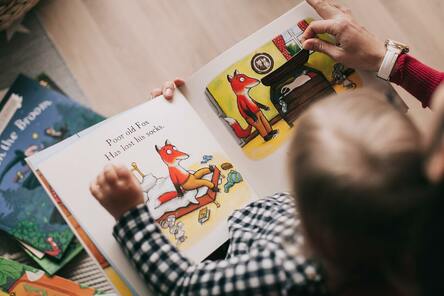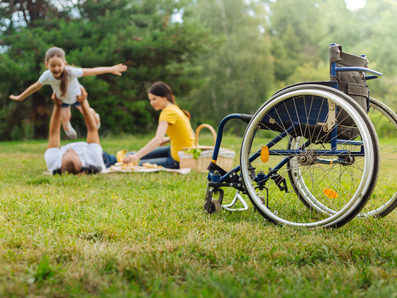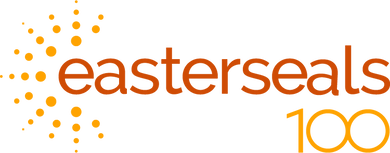 Easterseals of Northeast Central Florida recently welcomed Speech/Language Pathologist Gabriella Walton, M.S., CCC-SLP, to its team in Daytona Beach. In her role, Gabriella is responsible for assessing, diagnosing and determining courses of treatment for clients with speech and language challenges or disorders. Gabriella earned a Bachelor of Science degree in communication sciences and disorders from the University of Central Florida and a master's degree in speech language pathology from Nova Southeastern University. In her role at Easterseals, Gabriella works with client families who attend Easterseals Charter Schools and the Autism Center of Excellence, and consults with outpatient clients. "I love helping everyone find their voice." said Gabriella, who joined the team after the New Year. When not helping families at Easterseals, Walton enjoys playing tennis and traveling. Welcome, Gabriella! We're glad you're here. 1/24/2019 From the bookshelf: Titles that teach children about inclusion, disabilities and friendshipRead Now  Books can challenge perspectives. They introduce new ideas and clear up misconceptions. For adults and children alike, books open our worlds to new ways of thinking. Parents and teaches know all too well that teaching children inclusion, tolerance, how to love themselves and be a good friend to others is an important job. The good news is that many authors do too. Have you ever considered helping a child understand himself or see herself differently? Do the words come easily to you or are they difficult to find? Books can be such a gift in helping us find the right words to explain difficult concepts. Below are a few we found that may help you tell the story your child needs to hear, for his benefit as well as others’. Helping Sophia Sophia is a third grader who uses a wheelchair, and on a day when her usual helper isn’t in school, Sophia’s classmates step up to the plate to support her. The story informs enlightens children about children with disabilities while teaching caring and kindness. You, Me and Empathy Quinn is here to model the meaning of empathy in this charming story about understanding, compassion and kindness towards others. The book includes discussion questions and activities to promote this learned behavior in young readers. The Big Umbrella The School Library Journal describes The Big Umbrella as a “sweet extended metaphor uses an umbrella to demonstrate how kindness and inclusion work... A lovely addition to any library collection, for classroom use or for sharing at home.” The Big Umbrella is all about inclusivity and leaves opportunities for easy discussion when the story ends too. How to Be a Friend: A Book about Friendship Does your child know how to make friends? Teaching children the traits of being a good friend is the work of parents and teachers, but it’s not a skill readily taught in schools. The book’s author introduces children to the qualities that build good friendships, including loyalty, trust and honesty. Just Because In Just Because, Clemmie’s little brother expresses his love for his big sister, whom he adores though she can’t do many of the things most children can. He loves her no matter what and accepters her as he is. This charming read celebrates sibling friendship while lovingly unfolding Clemmie’s disabilities. Roxy the Raccoon: A Story to Help Children Learn about Disability and Inclusion Roxy has friends who love to do everything together, but sometimes that means making changes to plans and accommodating each other’s needs. This story from the forest teaches how to include friends with disabilities and why friends are happy to do so. Just Because I Am: A Child's Book of Affirmation No matter their abilities, all children deserve to value themselves and recognize their worth simply because they exist! This sweet book, full of affirmations, helps children understand their value, which doesn’t lie in what they do or what they look like. The read includes a discussion and activities section for parents, teachers and caregivers too. Not So Different: What You Really Want to Ask About Having a Disability He’s often asked what it’s like living with a disability, so Shane Burcaw answers them with humor and refreshing honesty in this fun book. More than any explanation of his abilities, he’s most effective in explaining how, in more ways than not, he’s just like everyone else. What's Different about You? This book offers a comprehensive look explaining medical conditions, impairments and disabilities in a kid-friendly and developmentally appropriate manner. It helps children understand such differences for more successful interactions at school, in public or even at home. (What’s Different About You? is touted as helpful in explaining topics to siblings of a child with a disability). All My Stripes: A Story for Children with Autism This Gold Medal/Mom’s Choice award-winning book shares the story of Zane, a zebra with autism who’s worried his differences will negatively impact his relationships with other students. As the book unfolds, Zane and his readers learn that autism is only one of the many qualities that make him unique, special and worth befriending. *** Congratulations on seeking new ways to teach your child how to interact with others in the most loving and kind ways! We invite you to research the above titles to determine reading level and whether the content meets your child’s specific needs. Together, we can help children understand how much they have in common and how their differences are worth treasuring too.  If you can’t remember what happens when you give a mouse a cookie, or why the pigeon wants to drive the bus, you may need to brush up on your reading – children’s book reading, that is. Reading to children ages 0 to Pre-K is a fun and effective way to help them develop their literary skills. Reading aloud to youngsters offers them numerous benefits, including building their imaginations and learning about their world and worlds they have yet to explore. In even the youngest children, reading supports social skills, basic speaking skills and increases their vocabulary. Books help children increase empathy too. All of these are some of the reasons Easterseals of Northeast Central Florida is recruiting readers for its 100 Leaders, 100 Readers program, which is kicking off soon in Daytona Beach and DeLand as part of Easterseals 100-Year Celebration. As part of 100 Leaders, 100 Readers, members of the community will be making guest appearances and reading aloud to students in Easterseals Charter Schools classrooms. (If you’re interested in this volunteer opportunity, please email Susan today!) If you’re out of practice reading books aloud to little ones, fear not. Check out these tips on how to keep your audience of youngsters captivated while you share your time and talents to support and encourage children’s literacy and Easterseals:
Pick up a children’s book today and read to a child you love, or join our 100 Leaders, 100 Readers program. As J.K. Rowing knows all too well, “…something very magical can happen when you read a book.” Sources: Pre-KPages.com, Pearson.com, ReadBrightly.com, ChildDevelopmentInfo.com, and Rasmussen.edu.  Everybody's fighting some kind of stereotype, and people with disabilities are no exception. The difference is that barriers people with disabilities face begin with people's attitudes — attitudes often rooted in misinformation and misunderstandings about what it's like to live with a disability. Myth 1: All persons who use wheelchairs are chronically ill or sickly. Fact: The association between wheelchair use and illness may have evolved through hospitals using wheelchairs to transport sick people. A person may use a wheelchair for a variety of reasons, none of which may have anything to do with lingering illness. Myth 2: Wheelchair use is confining; people who use wheelchairs are "wheelchair-bound." Fact: A wheelchair, like a bicycle or an automobile, is a personal assistive device that enables someone to get around. Myth 3: All persons with hearing disabilities can read lips. Fact: Lip-reading skills vary among people who use them and are never entirely reliable. Myth 4: People who are blind acquire a "sixth sense." Fact: Although most people who are blind develop their remaining senses more fully, they do not have a "sixth sense." Myth 5: People with disabilities are more comfortable with "their own kind." Fact: In the past, grouping people with disabilities in separate schools and institutions reinforced this misconception. Today, many people with disabilities take advantage of new opportunities to join mainstream society. Myth 6: Non-disabled people are obligated to "take care of" people with disabilities. Fact: Anyone may offer assistance, but most people with disabilities prefer to be responsible for themselves. Myth 7: Curious children should never ask people about their disabilities. Fact: Many children have a natural, uninhibited curiosity and may ask questions that some adults consider embarrassing. But scolding curious children may make them think having a disability is "wrong" or "bad." Most people with disabilities won't mind answering a child's question. Myth 8: The lives of people with disabilities are totally different than the lives of people without disabilities. Fact: People with disabilities go to school, get married, work, have families, do laundry, grocery shop, laugh, cry, pay taxes, get angry, have prejudices, vote, plan and dream like everyone else. Myth 9: It is all right for people without disabilities to park in accessible parking spaces, if only for a few minutes. Fact: Because accessible parking spaces are designed and situated to meet the needs of people who have disabilities, these spaces should only be used by people who need them. Myth 10: People with disabilities always need help. Fact: Many people with disabilities are independent and capable of giving help. If you would like to help someone with a disability, ask if he or she needs it before you act. Myth 11: There is nothing one person can do to help eliminate the barriers confronting people with disabilities. Fact: Everyone can contribute to change. You can help remove barriers by:
 What does 100 years look like? Does it look like wisdom, celebration, and more than a few birthday candles? This year, the national Easterseals organization is 100 years old, and it looks like all of that and more! In this centennial year, Easterseals of Northeast Central Florida is joining Easterseals affiliates across America in celebrating all abilities and limitless possibilities. Easterseals of Northeast Central Florida was founded 68 years ago, and at the time was named the Junior Service League Orthopedic Center in Daytona Beach. Though its name changed to Easter Seals of Volusia Flagler Counties’ and then Easterseals of Northeast Central Florida, its purpose has remained: To change the way the world defines and views disability by making profound, positive differences in people’s lives every day. In 2019, as we reflect upon Easterseals’ 100 years of national impact and nearly seven decades of local service, we honor our legacy and anticipate our future. We encourage YOU to be a part of the centennial celebration; here are a few ways you can enjoy it with us: Share your Easterseals story. You are an important part of our mission. Do you have an inspiring Easterseals story to share? We want to hear it! Email Susan Moor at [email protected] with your experience. Your experiences could help others in myriad ways, from encouraging them to seek support to changing their attitudes about disabilities. You never know how someone could be changed for the better by reading your Easterseals story. Expand the local Easterseals network. Do you follow Easterseals of Northeast Central Florida on Facebook or receive our email updates? Share our social posts and e-newsletters with your friends and family. Educating others about the services we provide for young and old, and no matter their abilities, can open doors for others’ advocacy and action. You can sign up for our e-mail updates on the right side of our homepage. Take our survey. We invite you to help Easterseals look into the future and its next 100 years. What do you think Easterseals’ goals should be for the next 100 years of serving the disability community? Take this short survey and share your thoughts. Gear up and get out. Join us for an Easterseals of Northeast Central Florida event this year. Our two hallmark, local fundraisers include Walk With Me (April 26, 2019) and Over the Edge at ONE DAYTONA (November 2, 2019), both in Daytona Beach. Walk With Me is a fundraising event to raise awareness and support for families living with disabilities. Individual walkers and teams join hundreds of other passionate people in their communities for a day full of entertainment, fun and, of course, our signature walk. Over the Edge at ONE DAYTONA invites you to catch your breath, step up to the edge and rappel down the famed International Motorsports Center. Rappelers raise funds and earn their spot on the ropes in this unique event. As we celebrate 100 years of national impact in the lives of individuals with disabilities, their families and communities throughout America, and nearly 70 years of local service, we invite you to join in the conversation, events and everyday mission of Easterseals. We embrace the future with a renewed commitment to enhance possibilities for people of all ages and abilities, and we thank you for journeying with us. #100Years #Easterseals #WeCelebrate #MyEastersealsMoment 1/7/2019 Emojis and Accessibility: The Dos and Don’ts of Including Emojis in Texts and EmailsRead Now by Beth Finke (The Easterseals Blog) A friend sent me a text the other day that said this: “Wishing you a prosperous new year excited face with money symbols for eyes and stuck-out tongue excited face with money symbols for eyes and stuck-out tongue excited face with money symbols for eyes and stuck-out tongue excited face with money symbols for eyes and stuck-out tongue. You guys free tonight? Give me a call.” I never got to the part where I was supposed to give them a call. The emojis got in the way. Five years ago I published a post here about how some people who are blind access a program called VoiceOver to use an iPhone — VoiceOver parrots every letter we type into a text, and a key next to the space bar on the iPhone keypad lets us choose from lists and lists and lists of emojis to use with texts. VoiceOver reads the images out loud for those of us who can’t see them. Let me show you what I mean. Here’s a sampling of what I hear when choosing from the list of “Smileys and other people” emojis:
You get the picture. Some of the blind people I know tweet and text using emojis, but usually just one per message. Multiple emojis might be easy to ignore if you see them all the time, but listening to multiple emojis? It’s time-consuming, and if you want to know the truth, kind of a pain. If you are texting a friend who uses a screen reader, or if you want your tweet to be accessible to all, including those of us with visual impairments, here are some simple tips: Don’ts
If you use texts or tweets to market your business, your blog, your YouTube channel, remember that each of your tweets and texts sends a message out to your community. Approximately 300 million people in the world are visually impaired, and over 50 million of us are totally blind. Go easy on the emojis, and we’ll get the message too! |
Details
Archives
May 2024
Categories
All
|

 RSS Feed
RSS Feed